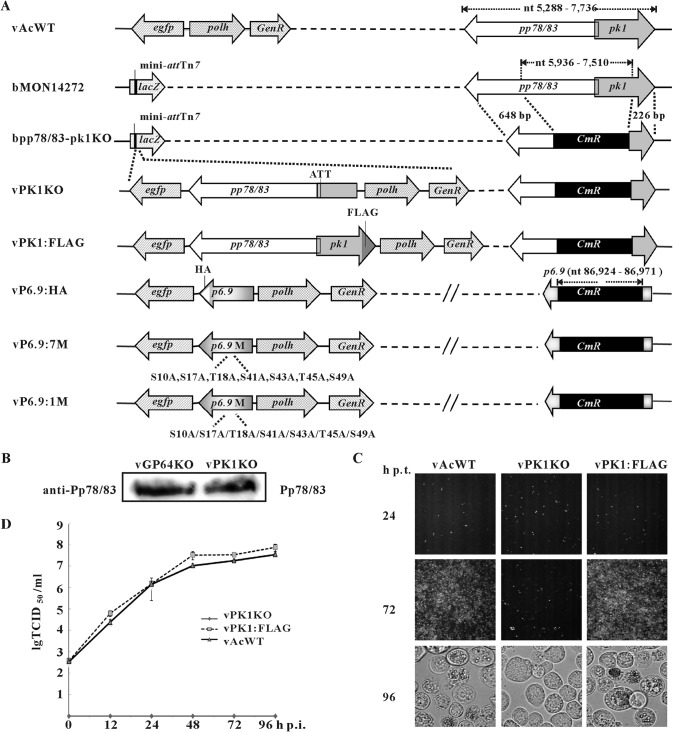FIG 3.
Construction of AcMNPV mutants. (A) Schematic diagram of the AcMNPV mutants used in this study. bpp78/83-pk1KO was constructed by replacing a 1,575-bp fragment of pp78/83 and pk1 in bMON14272 with a 1,038-bp CmR gene via Red/ET homologous recombination in Escherichia coli. The pp78/83-pk1-rescued virus (vPK1:FLAG) was constructed by transposing both gene cassettes of pp78/83 and pk1 tagged with a FLAG epitope as well as the polh and egfp genes into the mini-attTn7 locus of bpp78/83-pk1KO. vPK1KO was generated by inserting only the pp78/83, polh, and egfp genes into bpp78/83-pk1KO. To prevent the expression of a C-terminus-truncated pk1 mutant in insect cells, the initiation codon (ATG) of pk1 was mutated to ATT. vP6.9:HA contained a p6.9 ORF tagged with an HA epitope sequence as previously described (11). The 7 PK1-dependent Ser/Thr residues were replaced with Ala residues to construct vP6.9:7M. A series of P6.9-mutation viruses (vPK1:1M) were constructed as described for vP6.9:7M, in which each of the 7 PK1-dependent Ser/Thr phosphorylation sites were separately mutated to Ala. GenR, gentamicin resistance; CmR, chloramphenicol resistance. (B) Sf9 cells were transfected with vPK1KO bacmid. At 48 h p.t., the cells were immunoblotted with a rabbit polyclonal anti-Pp78/83 antibody. Cells transfected with vGP64KO bacmid were used as a positive control. (C) Sf9 cells were transfected with bacmids of vAcWT, vPK1KO, or vPK1:FLAG. At the indicated time points p.t., the cells were observed with a fluorescence microscope or a light microscope. (D) Sf9 cells were infected with vPK1:FLAG or vAcWT at an MOI of 5 TCID50/cell or supernatants from vPK1KO bacmid-transfected cells at 96 h p.t. The supernatants were harvested at the indicated time points p.i., and BV titers were determined using TCID50 assays. Each data point represents the average titer from three independent infections. The error bars represent the standard deviations lg TCID50/ml, the logarithm of the TCID50/ml value with base 10.

